Here is a playlist featuring some of the songs the students will be performing at Zimriyah. Please feel free to listen, practice and share at home!
Here is a playlist featuring some of the songs the students will be performing at Zimriyah. Please feel free to listen, practice and share at home!
We have been so engaged and productive since returning from our Passover break and are continuing to enthusiastically hone our creative and collaborative skills. For example, just today we worked together as a kehillah (yup – every person in our classroom – grown-ups and children alike!) at our train table, building underwater boats, magic freezing wands, and alligators!
We also recently decided to create a Veterinary Office in our Dramatic Play Area! We first looked at books and pictures of veterinary clinics. Many of us wanted to work with rainforest animals, so we further focused our research on tropical birds and reptiles. We then created signs for the clinic . . .
. . . and created crates, cages, trees, food . . . and even warming lights (for Herman the Worm, of course!)
In our clinic, we are taking care of sick parrots, snakes, a lizard, ducks, kittens and puppies. Our friends from home (including a turkey!) have also required check-ups from our many enthusiastic (yet gentle) veterinarians.
We even are sketching pictures of our sick animals – thereby sharpening our observation skills and our knowledge of dog anatomy!
Crystal, (our Met intern), will build upon our interests and is preparing to speak to us about animal safety and care. She will also be planning for an educator from the RISPCA (RI Society for the Prevention of Cruelty to Animals) to visit our classroom!
Our interest in the natural world and science isn’t limited to our Dramatic Play Area! We are also learning more about the rocks and minerals that are all around us. We discover them in our playground, our backyards, and at the seashore. And we also find them, of course, on our science table!
We have learned (while doing research and during our Circle Time conversations) that sand and crushed rocks are used to make gravel for driveways and concrete for our buildings. Stones like granite and marble are used for countertops, statues and to decorate buildings. We have discovered that human beings have used rocks for both decoration and tools for thousands of years: turquoise and amethysts adorn rings and necklaces; flint was used to make arrows; our strongest drill bits use diamonds. We have observed many of the rocks on our Science Table and documented our discoveries in our Science Journals. In addition, we are learning about the different components of rocks:
MINERALS are non-living compounds of elements that are found only in nature. They are the building blocks of rocks and can form crystals.
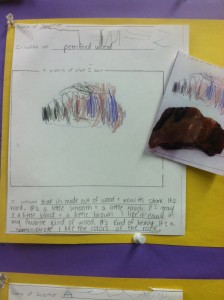
CRYSTALS are solid substances with atoms arranged in an orderly pattern which usually form smooth flat surfaces called faces.
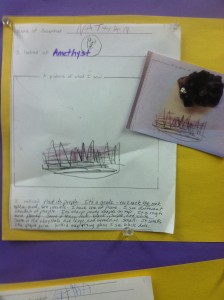
ROCKS are solid mixtures of one or more minerals. They make up the inorganic solid potion of the planet Earth.
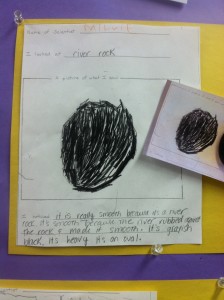
There are more than 1500 mineral species and over 100 kinds of rocks!
A “get up and dance” favorite! (comes with a CD) 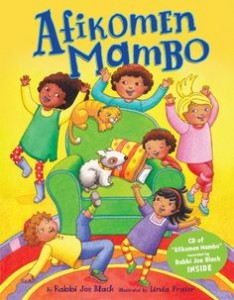
Visit our Pinterest site for great book selections as well as yummy Passover recipes! https://www.pinterest.com/jcdsri/passover-books-for-kids/ ![]()
We love books by Tami Lehman-Wilzig , who has been a Visiting Author at JCDSRI. Her website has children activities and more. http://www.tlwkidsbooks.com/ You will enjoy the recipes in her book 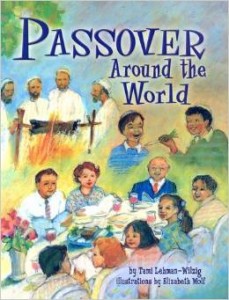
JCDSRI library suggestions:
Looking for some awesome books for girls that challenge stereotypes? Check out the extensive lists of great books at Mighty Girl. https://www.amightygirl.com/blog?p=2241
Read the informative remarks noted in, “Why Does Gender Matter? Counteracting Stereotypes with Young Children,” in the next paragraph.
Some of my personal favorites that our students love:
“Picture books provide role models for children in defining standards for feminine and masculine behavior, yet sexism manifests itself in diverse ways in children’s literature. Nonsexist books, on the other hand, produce positive changes in self-concept, attitudes, and behavior. Children’s gender attitudes may be positively changed through the reading of appropriate children’s literature and other book-related activities (Blumberg, 2008). Parents and teachers are encouraged to critically evaluate books for gender bias. However, rather than eliminating all books with stereotypes, adults can guide children to recognize stereotypes and increase independent critical thinking about gender and perceptions of gender. Making a concerted effort to provide positive, empowered stories and images of diverse characters will activate positive self-concepts for children and promote anti-bias attitudes.” (Dimensions of Early Childhood. “Why Does Gender Matter? Counteracting Stereotypes With Young Children.” Vol. 39, No. 3, 2011)
Our students use their vibrant imaginations, working memories, and scientific knowledge to build intricate structures using blocks, Magnatiles, Legos and cardboard (our collaboratively created Persian palace is but one example!) We now understand that adults use similar skills to create and care for real-world bridges throughout our state.
Our kehillah warmly welcomed two special visitors from the bridge design section of the Rhode Island Department of Transportation (RI-DOT) to our classroom. Mr. Noorparvar (Laurie’s husband!) and Mr. Mike Savella work in the Bridge Design section of the RI-DOT; they are principle project engineers who oversee several DOT projects and both are involved in designing new bridges and rehabilitating existing bridges. Our kehillah understands that caring for our state’s infrastructure is essential (including maintaining the 700+ bridges in Rhode Isand). “Bridges are important so that people can’t fall into the ocean or any kind of water!” explained Shira. “Or fall on other roads – they help us cross roads,” said Aeden.
“Before we begin,” said Mr. Noorparvar, “we need to talk about safety.” He explained that DOT employees use special objects to keep them safe when they are working on construction sites. First, Mr. Noorparvar pointed to the vest he was wearing; “It has bright colors so people can see and it glows in the dark!” exclaimed Nathan. Then Mr. Noorparvar showed us his hard-hat (“that’s so your head doesn’t get hurt!” explained Leo. “If something falls on your head, the helmet protects you!” said Zemer. “They are like a bike helmet!” exclaimed Aeden.) Mr. Noorparvar showed us a special DOT flashlight and his construction boots with steel in them (“they make a loud sound when you hit them!” giggled Asher).
Mr. Mike and Mr. Noorparvar also showed us a tape measure that they said was 125 feet long. “That’s so very long! As long as our whole school,” said Sabine. Later on during their visit, we unfurled the tape measure and discovered that it reached from one end of our hallway to the other!
Mr. Mike and Mr. Noorparvar brought in models of different kinds of bridges, including arch bridges . . .
. . . covered bridges, post-tension brides, draw-bridges (“I saw a very rusty bridge like that and it was stuck up in the air,” exclaimed Adrian), truss bridges, and suspension bridges (RI has two of them – the Newport Bridge and the Mt. Hope Bridge! “I went on one before and it’s my favorite kind of bridge,” said Zemer. “I’ve been on the red Golden Gate Bridge a thousand times! That’s a suspension bridge,” explained Aeden.)
While investigating the bridges, our two special guests taught us about bridge design. We were excited to learn that arches and columns are used to build bridges . . . just like our Shushan Palace! Mr. Mike and Mr. Noorparvar also taught us that a square shape is not very strong. If, though, we brace squares through the middle, we create two connected triangles – and then we have the strongest shape for building bridges!
“Triangles are so lucky ‘cause they are so strong,” Shira said decidedly.
Showing us a bridge they had created from popsicle sticks, we were told that the triangles created a sturdy structure – strong enough that it could hold us up! Most of us thought the bridge looked too small and delicate to support us (“We might break them if we step on them,” said Millie). We were able to see what would happen, though, if we stood on them . . .
“Hey, they do hold us up!” exclaimed Millie.
* * * * * * *
Our Pre-K designers and engineers are now enthusiastically creating bridges in our block area. We invite you to visit our classroom so we can share with you some of our creations!
What a great time we had decorating our room for Purim – a festive holiday filled with lots of noise costumes, decorations, masks, sweets, and good deeds.
We learned that the Purim story took place in the town of Shushan, Persia (currently Iran). As a result, we studied the architecture and art of both ancient Persia and the Middle East and adorned our room with pictures of ancient Persian architecture.
During our research, we saw pictures of intricate mosaics and many bright blue windows and doors. We learned that domes, columns, geometric shapes, nature-based patterns and vibrant colors are a rich part of Iran’s art and architecture.
Building upon these observations and deepening our understanding of patterns and sorting, we filled our science table with small toys, buttons, shapes and gems. We practiced sorting these treasures according to size, color, kind, shape, texture, width or height (and we’re still thinking of other classifications!)
We also created patterns on paper using supplies from our Art Center!
Utilizing this experience with creating patterns, as well as our knowledge of Persian architecture and art, we decided to recreate our very own vision of Shushan in our classroom using wood, screws, paint . . .
. . . tissue paper, oil pastels, cardboard, glue, paper . . .
. . . jewels, glitter, markers and stickers.
We have made domes, arches mosaics, and palaces.
In addition, to transforming our classroom, we also changed our appearances by creating masks. When creating these masterpieces, we not only improved our math, literacy and fine motor skills, but we practiced working collaboratively, strengthened our working memories and honed many other executive functioning skills (like impulse control and goal-directed persistence).
Deepening our understanding of the Purim story itself, we created some of its characters from paper and fabric.
This project required that we reflect on each character’s role in the story, his/her influences and responsibilities, and his/her choices. This helped to deepen both our literary skills as well as our empathic abilities. If you are interested in a trip back to ancient Persia, we invite you to visit our classroom! We look forward to giving you a tour.
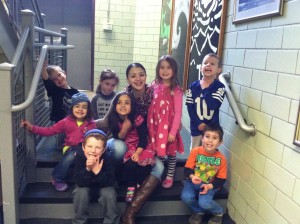 *Crystal – our newest MET intern – with some of her PreK friends*
*Crystal – our newest MET intern – with some of her PreK friends*
We are so pleased that our kehillah will be welcoming another new student from the MET High School in Providence (http://metcenter.org) to our classroom. Crystal Martinez will be joining us on Wednesdays and Fridays; she has chosen our PreK for her internship and Andrea will be mentoring her. Crystal has already spent a few days with us in our classroom and we are already captivated by her enthusiasm, warmth, and genuine interest in education – and in each of us! We are all so happy she will be part of our kehillah. We asked Crystal to write a paragraph introducing herself to our community:
Dear Parents and Staff of the Jewish Community Day School:
I wanted to introduce myself; my name is Crystal Martinez, and I’m a sophomore at the Met high school. I am 16 years old and I am an intern in Andrea, Ilana and Laurie’s lovely Pre-K classroom on Wednesdays and Fridays. My all -time dream would be to become a veterinarian. I’m very interested in working with animals, but I also adore children and that’s why I’m interning with Andrea and writing this letter to you now. Believe me when I say that your kids are so lucky to attend the JCDS. The way the staff does things is so unique and effective for the children. It’s amazing! My main goal in my time at JCDS is to form a connection with each student, because there’s nothing better than having a relationship with someone who has a super imagination and is always in the mood to color or go hula-hooping at any time of the day!
I’ve recently earned my RIELDS (Rhode Island Early Learning and Development Standards) certification. Through that class I learned about child development from the ages of 48 months to 60 months. It was very interesting, and I learned a lot from it. In addition to that classroom experience, I also have hands on experience working with children. Not only have I grown up surrounded by children, but I had an earlier internship at the Children’s Workshop. I am really looking forward to continuing to work with your children. I am thankful for the opportunity to work with them, and I thank you for taking your time to read this.
Sincerely, Crystal
Our PreK is a community of students deeply engaged in exploration, discovery, and reflection.
And no matter what we are doing – whether it be painting, meditation, or cooking – we are practicing a set of skills called executive functioning skills.
These high-level cognitive functions enable us to manage our emotions and monitor our thoughts in order to work more efficiently, effectively, and collaboratively. They help us to organize our behavior and override immediate demands in favor of longer-term goals. They also help us to respond appropriately to the limits and consequences of everyday life with responsibility, adaptability, flexibility, and integrity.
Requiring a lot of time to practice and learn, they are all skills that “stick” when taught consistently and meaningfully beginning in the earliest of grades. They are reinforced when children construct their own learning experiences (a core characteristic of our progressive classroom). Research shows that executive skills are necessary for future academic successes and ensure that we might become reflective, respectful, and responsible members of our communities.
♥
What are some of the names of these executive skills and how might we practice them in our classroom? A few examples: when our students construct a detailed and complex palace out of blocks or create the Mayflower ship from cardboard, paper, duct-tape, and paint, they are acquiring sophisticated “planning skills” and practicing “goal-directed persistence.”
When they create and illustrate their own classroom rules, our students are strengthening their “response inhibitions.”
Creating a doctor’s office in our Dramatic Play Area? That sparks their “working memories!”
And t’fillah, meditation, and yoga hones our students’ “sustained attention skills” and “emotional control.” And using our Peace-Table and Feelings Journal? That requires “reflection” and “metacognition!”
All of these activities build the skills for future student successes in school . . . and in life.
Did you ever try painting with a magnet? We have! It almost seems like magic that paint can travel over paper without the touch of a hand.
How did we do it? We placed a piece of paper on a tray and dripped several drops of paint on the paper. We choose different objects to place on the paper and then slid a magnet over the bottom of the container.
We were thrilled to discover what we could create!
In addition, during the last few weeks our science table has been filled with magnets.
We have used our scientific skills to observe different magnets and document our discoveries.
We have determined that magnets come in many different shapes, sizes and strengths!
Below are some of our observations (to see all our Science Journal entries, check out the bulletin board in our classroom):
We are learning that magnetism is a form of energy that makes some metal objects jump, spin, or stick to other metals.
Many of us were surprised to discover that magnets do not attract all metal objects! A magnet will not pick up aluminum foil or a penny (magnets only move objects made from iron, steel, nickel, or cobalt.)
We have also been learning about snowflakes both in our classroom and in Design Lab with Ms. Guttin. We have enjoyed creating our own snowflakes (our research revealed that every snowflake has 6 sides!) out of Lego, wooden shapes, paper . . .
and finally pipe cleaners, water and Borax!
We first created a snowflake shape by cutting pipecleaners and tying them together.
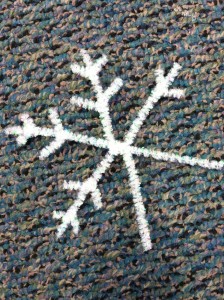 We then mixed hot water and Borax together in a bowl and suspended the “snowflake” from the top.
We then mixed hot water and Borax together in a bowl and suspended the “snowflake” from the top.
Over time, we observed that the solution was attracted to the pipcleaner and began to create crystals.
Our “snowflakes” are hanging on our back bulletin board; we invite you to see them!
Over the last few weeks as we have been preparing to observe Martin Luther King Jr. Day, we learned about Dr. King’s legacy and reflected on our own visions for making the world a better place for all people. Anchoring our discussions and play are the beliefs that all people are made in the image of God (be’zelem Elohim) and that we are responsible for making the world a better place.
During our conversations, we talked about some of the injustices Dr. King experienced in his lifetime (our understandings about the ways in which we are alike and different helped to shape these discussions. Part of our learning is documented on the lobby bulletin board – please check it out!) We learned that Martin Luther King – and the many people who worked with him during the civil rights movement – were upstanders. An upstander is a person who knows what’s happening is wrong and then works to make it right. In comparison, a bystander is someone who witnesses injustice or inequity and doesn’t get involved. The work of civil rights participants and social justice advocates (both then and now) help us to understand the saying (written in Pirkei Avot): “It is not incumbent upon you to finish the task. Yet, you are not free to desist from it.”
Along with Rosa Parks, Rabbi Abraham Joshua Heschel and many, many thousands of men, women and children, MLK worked to change people’s beliefs and attitudes, as well as the laws of the land. During our conversations, we also acknowledged that there is still so much more work to be done and reflected on the ways in which we could build on Dr. King’s legacy of repairing our world (tikkun olom).
Some of us imagined a time when all people will sing “Stop in the Name of Love” when they see something bad and then use the peace table. Other children suggested that we should visit people in the hospital who are sick, pick up trash in playgrounds, and teach people to say our mantra: “I am peaceful.” Still others said they wanted to change unfair laws, build ramps in all buildings for people who use wheelchairs and “teach people to solve a problem in a peaceful way.” Our reflections are posted on our chalkboard in the back of our room; we encourage you to read them in their entirety!
* * * * * * * *
We all agreed that we want, like MLK, a peaceful world in which children and grown-ups alike will remember to use “treat each other with kavod.” We will continue to build upon our discoveries as we reflect on issues of diversity, tolerance and respect throughout our year together. We affirm that our kehillah – community – is built upon the foundation of shared values, goals and concerns. At the same time, we can only continue to grow and learn when we recognize and nurture the differences and diversity among us. We are all unique individuals with differing interests, backgrounds, families, beliefs and personalities. Indeed, our kehillah works every day to reaffirm Dr. King’s words that “darkness cannot drive out darkness; only light can do that. Hate cannot drive out hate; only love can do that.”
* * * * * * * * *
Wishing you a meaningful holiday.
* * * * * * * * *
Below is more of the text from our reflections on what makes us alike and different. See our previous post and the lobby bulletin board for the more illustrations & text):
We are all alike. We like to play in PreK.
We are all different.
Some of us like to pretend to be doctors.
Some of us like to play family of doggie.
Some of us like to play in the block area.
Some of us like to color.
Some of us like to be scientists.
Some of us like to use the Peace Table.
We are all alike. We all have families.
We are all different.
Some of us live with moms.
Some of us live with dads.
Some of us live with moms and dads.
Some people live with two moms.
Some people live with grandparents.